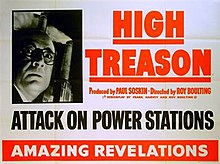High Treason (1951 film)
| High Treason | |
|---|---|
 Original British quad poster | |
| Directed by | Roy Boulting |
| Written by | Roy Boulting Frank Harvey |
| Produced by | Paul Soskin |
| Starring | Liam Redmond Anthony Bushell André Morell |
| Cinematography | Gilbert Taylor |
| Edited by | Max Benedict |
| Music by | John Addison |
Production company | Conqueror Films |
| Distributed by | General Film Distributors Peacemaker Pictures (US) |
Release date |
|
Running time | 90 minutes |
| Country | United Kingdom |
| Language | English |
| Budget | £168,325[1] |
| Box office | £88,000[2] |
High Treason is a 1951 British spy thriller.[3][4] It is a sequel to the film Seven Days to Noon (1950) from the same team. Director Roy Boulting, co-director (with his brother John) and co-writer of the first film also directed and co-wrote this one.[4] Frank Harvey, Boulting's co-writer, was also a co-writer of the earlier film. André Morell reprises his role as Detective Superintendent Folland of Scotland Yard's Special Branch from the first film, though in High Treason he is subordinate to the head of Special Branch, Commander Robert "Robbie" Brennan, played by Liam Redmond.[5]
Plot
Enemy saboteurs infiltrate the industrial suburbs of London, intending to disable three power stations in London and five other stations elsewhere, all strategically located throughout the UK. Their motive is to cripple the British economy and to enable subversive forces to insinuate themselves into government. The saboteurs are thwarted, not by counterintelligence agents, but by workaday London police officers, and finally by a repentant betrayer from their own ranks.
Cast
- Liam Redmond as Commander Robert Brennan
- André Morell as Superintendent Folland
- Anthony Bushell as Major Elliott
- Kenneth Griffith as Jimmy Ellis (Soviet agent)
- Patric Doonan as George Ellis
- Joan Hickson as Mrs Ellis
- Anthony Nicholls as Sir Grant Mansfield, M.P. (Head Soviet agent, and putative Prime Minister after the incumbent government's overthrow)
- Mary Morris as Anna Braun (Soviet agent)
- Geoffrey Keen as Morgan Williams (Soviet agent)
- Stuart Lindsell as Commissioner
- John Bailey as Stringer
- Dora Bryan as Mrs Bowers
- Charles Lloyd-Pack as Percy Ward
- Laurence Naismith as Reginald Gordon-Wells
- Michael Ward as Music Club Member (uncredited)
- Dandy Nichols as Doorstep Cleaner (uncredited)
- Alfie Bass as Albert Brewer (uncredited)
- Jean Anderson as woman in street (uncredited)
- Glyn Houston as railway shunter (uncredited)
- Peter Jones announcer at music club (uncredited)
- Moultrie Kelsall as ship's captain (uncredited)
- Howard Lang as policeman who discovered Jimmy's body (uncredited)
- Harry Locke as Andy, the telephone engineer (uncredited)
- Victor Maddern as anarchist (uncredited)
- Tony Quinn as chemistry lecturer (uncredited)
- Marianne Stone as Alfie's mother (uncredited)
- Bruce Seton (uncredited)
Critical reception
An unnamed New York Times reviewer commented, "it is worthy to note that High Treason travels at a more leisurely pace than Seven Days, but Roy Boulting, who also directed, achieves an equally intelligent handling of the many pieces needed to fit his intricate jigsaw of a plot," and remarked that, "deft direction, crisp dialogue and a generally excellent cast gives High Treason a high polish," concluding that the film is "a taut tale and a pleasure".[6]
In 2013, a contributor to Cageyfilms.com wrote, "although the politics of High Treason are as dated as those of Leo McCarey's My Son John (1952), the location shooting in London and the character details around the periphery of the narrative provide a fascinating documentary portrait of the metropolis just a few years after the war and, as in Sam Fuller's Pickup on South Street, the ostensible political element can be seen as little more than a MacGuffin on which to hang the narrative. And speaking of MacGuffins, the film has several very well-developed Hitchcockian elements, particularly the pretentious modern music society which serves as a front for the communist plotters and the labyrinthine building which doubles as a tutorial college and secret commie headquarters".[7]
References
- ^ Chapman, J. (2022). The Money Behind the Screen: A History of British Film Finance, 1945-1985. Edinburgh University Press p 358
- ^ BFI Collections: Michael Balcon Papers H3 reprinted in British Cinema of the 1950s: The Decline of Deference By Sue Harper, Vincent Porter p 41
- ^ "High Treason (1951)". BFI. Archived from the original on 12 July 2012.
- ^ a b Hal Erickson. "High Treason (1951) – Roy Boulting – Synopsis, Characteristics, Moods, Themes and Related – AllMovie". AllMovie.
- ^ "Overview for Andre Morell". Turner Classic Movies.
- ^ "'High Treason,' J. Arthur Rank Production, Has U. S. Premiere at 52d Street Trans-Lux". The New York Times. 21 May 1952. Retrieved 10 April 2017.
- ^ "Damned Treason". cageyfilms.com.
External links
- High Treason at IMDb